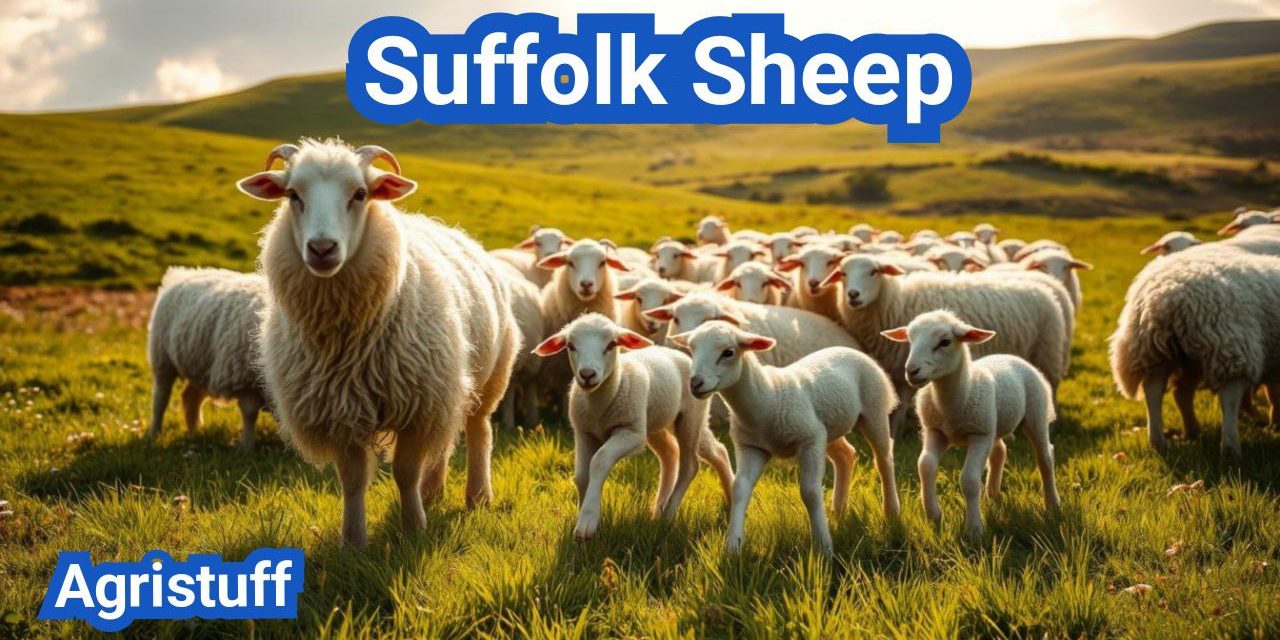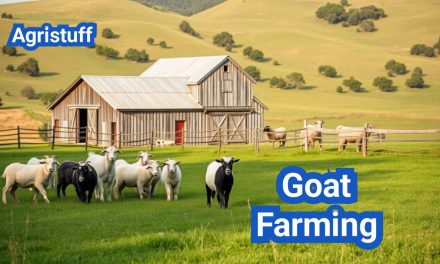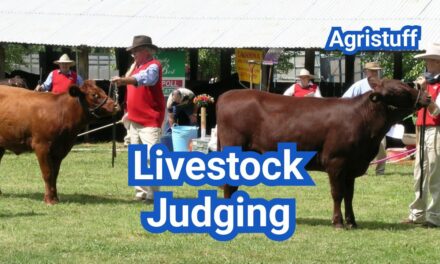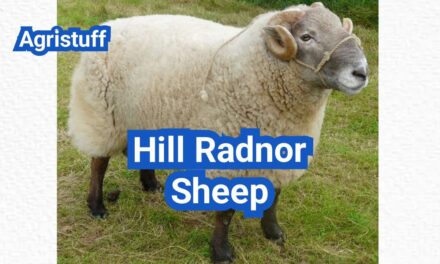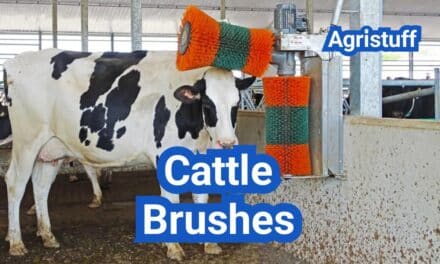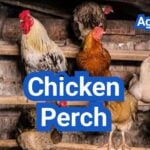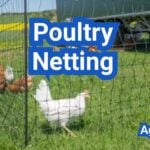The Suffolk Sheep is a renowned breed in the livestock industry, particularly for its fast-growing nature and popularity in meat production.
Originating in the late eighteenth century in Suffolk, England, this breed was developed by cross-breeding Norfolk Horn ewes with improved Southdown rams.
Their fast-growing characteristic makes them a preferred choice among farmers and livestock breeders.
Key Takeaways
- Originated in Suffolk, England in the late 18th century.
- Known for their fast-growing nature.
- Popular breed for meat production.
- Developed from cross-breeding Norfolk Horn ewes and Southdown rams.
- Preferred by farmers and livestock breeders.
The Origin and History of Suffolk Sheep
With roots tracing back to England, the Suffolk Sheep has a storied past that has contributed to its widespread adoption. The breed was developed in the late 18th and early 19th centuries by crossing Southdown rams with Norfolk Horn ewes, resulting in a hardy, fast-growing animal well-suited for the British climate.
British Roots and Development
The Suffolk Sheep breed was developed in the counties of Suffolk and Norfolk, England. The breed’s early development was influenced by the need for a sheep that could thrive in the local climate and produce high-quality meat. The Southdown rams were used to improve the carcass quality, while the Norfolk Horn ewes contributed to the breed’s hardiness and maternal traits.
The breed quickly gained popularity due to its excellent growth rate, hardiness, and the quality of its meat. By the mid-19th century, the Suffolk Sheep had become a staple in British agriculture, prized for its ability to produce prime lambs.
Global Spread and Modern Significance
As British agricultural practices were exported around the world, the Suffolk Sheep breed was introduced to many countries, including the United States, Australia, and New Zealand. Today, the Suffolk Sheep is one of the most numerous breeds globally, playing a significant role in the sheep industry.
The Suffolk Sheep Society has been instrumental in promoting the breed and maintaining its standards. The society has played a crucial role in the breed’s global spread by providing breeding stock and supporting breeders worldwide.
The Suffolk Sheep’s significance extends beyond its numbers; it has contributed to the development of many other breeds through cross-breeding programs. Its influence can be seen in the improvement of meat production traits in various sheep breeds around the world.
Understanding Suffolk Sheep Characteristics
Suffolk Sheep are renowned for their impressive size and distinctive appearance. They are a popular breed among farmers and shepherds due to their robust build and high-quality meat production.
Distinctive Physical Features and Appearance
Suffolk Sheep are easily recognizable due to their black faces and legs, contrasting with their white wool. This distinctive coloring is a hallmark of the breed and contributes to their popularity. The breed has a robust build and is known for its muscular appearance, which is indicative of its growth potential and meat production capabilities.
The fleece of Suffolk Sheep is of medium quality, with a staple length that is generally considered suitable for various textile applications. While not the primary focus for wool production, their fleece is still valued for its quality.
Size, Weight, and Growth Expectations
Suffolk Sheep are known for their large size. Rams typically weigh up to 350 pounds, while ewes can weigh up to 250 pounds. Their growth rate is exceptionally high, making them a preferred choice for meat production. The breed’s ability to gain weight quickly is a significant advantage for farmers looking to produce high-quality lambs efficiently.
According to industry experts, “Suffolk Sheep are bred for their rapid growth rate and muscular development, making them ideal for cross-breeding programs aimed at improving meat production in other breeds.”
“Suffolk rams are often used as terminal sires due to their ability to impart rapid growth and muscular development to their offspring.”
– Sheep Breeding Expert
Lifespan and Developmental Stages
The average lifespan of Suffolk Sheep is around 6 to 8 years, although this can vary based on factors such as breeding practices, nutrition, and health management. Ewes typically begin breeding at around 1 to 2 years of age, and their reproductive lifespan can extend for several years.
- Lambing typically occurs once a year, with most ewes giving birth to 1 to 2 lambs per lambing.
- The lambs grow rapidly, reaching market weight within 6 to 8 months.
- Proper nutrition and health care are crucial during the early developmental stages to ensure the lambs reach their full growth potential.
Understanding the characteristics of Suffolk Sheep, including their physical features, size, weight, and lifespan, is essential for farmers and breeders looking to maximize their production potential.
Suffolk Sheep Varieties and Bloodlines
The Suffolk Sheep breed encompasses a range of varieties, each with distinct characteristics and advantages. This diversity is a result of selective breeding practices and regional adaptations, making Suffolk Sheep a versatile choice for farmers worldwide.
Traditional Black-Faced Suffolk
The traditional black-faced Suffolk is one of the most recognized varieties within the breed. Known for its robust build and black face, this variety has been a cornerstone of sheep farming in many regions. The black-faced Suffolk is prized for its:
- Hardiness: Adaptability to various climates and farming conditions.
- Growth Rate: Rapid growth, making it suitable for meat production.
- Meat Quality: High-quality meat with good marbling, enhancing its market value.
White Suffolk Development and Traits
The white Suffolk is another significant variety, developed primarily for its white or light-colored fleece. This variety has gained popularity in certain markets due to its:
- Ease of shearing: White Suffolks often have a more manageable coat.
- Fleece quality: The fleece is soft and highly valued for textile production.
Regional Variations (American, British, Irish)
Regional variations of Suffolk Sheep have developed due to local breeding practices and environmental conditions. For instance:
- American Suffolk: Often larger and bred for rapid growth, catering to the large-scale meat production industry.
- British Suffolk: Known for its hardiness and is often used in cross-breeding programs to improve flock resilience.
- Irish Suffolk: Adapted to the local climate, Irish Suffolks are valued for their fertility and maternal traits.
Understanding these regional variations is crucial for farmers looking to select the most appropriate Suffolk Sheep variety for their specific needs and conditions.
How to Select Quality Suffolk Sheep

High-quality Suffolk Sheep are the backbone of a profitable and sustainable sheep farming business. Selecting the right animals involves careful consideration of several factors, including breeding stock quality, price, and overall value.
Evaluating Breeding Stock
When evaluating breeding stock, several key characteristics should be considered. Physical conformation is crucial, as it directly impacts the animal’s productivity and longevity. Look for sheep with a robust build, well-aligned legs, and a strong bone structure.
Another important factor is the genetic potential of the breeding stock. Suffolk Sheep are known for their fast growth rates and high-quality meat production. Ensure that the animals you select come from a lineage with a proven track record of these desirable traits.
Price Considerations and Value Assessment
The price of Suffolk Sheep can vary significantly based on factors such as age, quality, and pedigree. It’s essential to conduct a thorough value assessment to ensure you’re getting the best possible return on your investment.
Consider the following when assessing value:
- The animal’s growth rate and potential for meat production
- The quality of the animal’s pedigree and its potential for breeding
- The overall health and condition of the animal
By carefully evaluating these factors, you can make informed decisions when selecting Suffolk Sheep for your farm or breeding program.
Setting Up Your Suffolk Sheep Farm
Establishing a Suffolk Sheep farm requires meticulous planning and a thorough understanding of the land and equipment needs. To ensure a successful venture, it’s crucial to assess your resources and plan accordingly.
Land and Space Requirements
The first step in setting up your Suffolk Sheep farm is to evaluate your land and space requirements. Suffolk Sheep need adequate grazing land, and the quality of the pasture directly impacts their growth and health. A general rule of thumb is to allocate 1 to 2 acres per sheep, depending on the quality of the grazing land and the climate.
It’s also essential to consider the topography of your land. Suffolk Sheep are adaptable to various terrains, but well-drained land is crucial to prevent health issues such as foot rot. Ensuring that your land has adequate drainage and is free from hazards will contribute to the overall health and productivity of your flock.
Initial Investment Planning
Initial investment planning is a critical aspect of setting up a Suffolk Sheep farm. The costs involved include purchasing the initial flock, land preparation, fencing, shelter construction, and equipment. A detailed breakdown of these costs will help you plan your budget more effectively.
- Purchasing high-quality breeding stock
- Land preparation and fencing
- Shelter and infrastructure development
- Equipment such as feeding troughs, watering systems, and handling facilities
It’s advisable to create a comprehensive business plan that outlines your initial investment, ongoing expenses, and projected income. This will not only help in securing funding but also in making informed decisions throughout your farming journey.
By carefully planning your land use and initial investments, you can establish a thriving Suffolk Sheep farm that is both profitable and sustainable.
Housing and Fencing Requirements

Creating a safe and healthy environment for Suffolk Sheep requires careful consideration of their housing and fencing needs. Adequate shelter and secure fencing are essential to protect these animals from predators and harsh weather conditions.
Shelter Design and Construction
The design and construction of shelters for Suffolk Sheep should prioritize ventilation, dryness, and protection from the elements. A well-designed shelter can significantly improve the health and productivity of the flock.
Key considerations for shelter design include:
- Ensuring adequate ventilation to prevent respiratory issues
- Using materials that are durable and easy to clean
- Providing enough space for all sheep to stand comfortably
Fencing Options for Suffolk Sheep
Fencing is a critical component of Suffolk Sheep management, serving to contain the flock, protect them from predators, and define grazing areas. The choice of fencing depends on several factors, including the size of the area, the number of sheep, and the local environment.
Popular fencing options for Suffolk Sheep include:
| Fencing Type | Durability | Cost |
|---|---|---|
| High-Tensile Wire Fencing | High | Moderate |
| Wooden Fencing | Moderate | High |
| Electric Fencing | Moderate | Low |
Each fencing type has its advantages and disadvantages, and the best choice will depend on the specific needs and circumstances of the farm.
Complete Feeding Guide for Suffolk Sheep

Understanding the nutritional needs of Suffolk sheep is essential for their optimal care. Suffolk sheep, known for their fast-growing and muscular build, require a diet that supports their growth and health.
Daily Nutritional Requirements
Suffolk sheep need a balanced diet that includes adequate protein, energy, vitamins, and minerals. The daily nutritional requirements can vary based on factors such as age, size, and stage of production.
Nutritional Needs Based on Life Stage:
- Lambs: High protein for growth and development
- Ewes: Balanced nutrition for maintenance, pregnancy, and lactation
- Rams: Adequate energy and protein for breeding
| Nutrient | Lambs | Ewes | Rams |
|---|---|---|---|
| Protein (%) | 16-18 | 12-14 | 14-16 |
| Energy (MJ/kg) | 10-12 | 9-11 | 10-12 |
| Calcium (%) | 0.8-1.0 | 0.6-0.8 | 0.7-0.9 |
Seasonal Feeding Adjustments
Seasonal changes can significantly impact the nutritional needs and feeding strategies for Suffolk sheep. For instance, during winter, sheep may require more energy to stay warm, while in summer, they may need more hydration.
Winter Feeding: Increase energy-rich feed to help sheep maintain body heat.
Summer Feeding: Ensure access to plenty of fresh water and consider providing shade to reduce heat stress.
Supplementation and Special Needs
Supplementation is crucial for ensuring that Suffolk sheep receive all necessary nutrients, especially when their dietary needs are not fully met by their regular feed.
Common Supplements:
- Mineral blocks or loose minerals
- Vitamin supplements
- Protein-rich feeds for lambs or lactating ewes
It’s essential to consult with a veterinarian or a qualified sheep nutritionist to determine the best supplementation strategy for your flock.
Breeding and Lambing Management

Breeding and lambing management play a pivotal role in the productivity and profitability of Suffolk Sheep farms. Effective management during these critical periods ensures the health and well-being of both ewes and lambs, ultimately impacting the overall success of the farm.
Breeding Season Preparation
Preparing for the breeding season involves several key steps. First, it’s essential to ensure that both rams and ewes are in optimal health and condition. This includes providing a nutritious diet and ensuring that all animals have received necessary vaccinations and health checks.
- Review the breeding program and select rams based on genetic merit and fertility.
- Ensure ewes are free from reproductive issues and are at an ideal body condition score.
- Plan the breeding season to achieve a compact lambing period.
Ewe Care During Pregnancy
Proper care during pregnancy is vital for the health of both the ewe and her lambs. Nutritional needs change throughout the pregnancy, and careful monitoring is required to prevent complications.
| Stage of Pregnancy | Nutritional Requirements | Health Checks |
|---|---|---|
| Early Pregnancy | Maintenance diet | Regular checks for parasites and overall health |
| Late Pregnancy | Increased energy and protein | Monitoring for pregnancy toxemia and other complications |
Lambing Process and Newborn Care
The lambing process requires careful supervision to ensure a smooth delivery and to intervene if necessary. After lambing, newborn care is critical for the lamb’s survival and health.
Key steps during lambing and newborn care include:
- Monitoring ewes closely for signs of lambing.
- Assisting with difficult births.
- Ensuring lambs receive colostrum promptly after birth.
- Monitoring lambs for signs of illness or distress.
By focusing on these critical aspects of breeding and lambing management, Suffolk Sheep farmers can improve the health, productivity, and profitability of their farms.
Suffolk Sheep as Meat Producers

The Suffolk Sheep breed is highly regarded for its fast growth rate and high-quality meat. This characteristic makes them an ideal choice for farmers and consumers looking for superior meat production.
Growth Rate and Development Timeline
Suffolk Sheep are known for their rapid growth rate. Lambs born to Suffolk ewes typically reach market weight quickly, often within 6 to 8 months. This fast growth rate is due to their genetic predisposition and efficient feed conversion.
Carcass Yield and Meat Quality
The carcass yield of Suffolk Sheep is another significant advantage. They produce lean, muscular carcasses with a high yield of saleable meat. The meat quality is also superior, with fine texture and good flavor.
Market Advantages of Suffolk Meat
Suffolk Sheep meat enjoys several market advantages. The breed’s reputation for producing high-quality, lean meat commands a premium price in many markets. Additionally, the consistency of Suffolk Sheep meat makes it a favorite among consumers and retailers alike.
| Breed | Growth Rate | Carcass Yield | Meat Quality |
|---|---|---|---|
| Suffolk | Fast | High | Superior |
| Dorper | Fast | Medium | Good |
| Merino | Medium | Low | Fine |
In conclusion, Suffolk Sheep offer a compelling combination of growth rate, carcass yield, and meat quality, making them a preferred choice in the meat production industry.
Using Suffolk Rams as Terminal Sires

The use of Suffolk Rams as terminal sires has become a popular practice among sheep breeders due to their ability to produce fast-growing lambs. This approach is particularly beneficial in commercial sheep operations where the focus is on maximizing meat production efficiency.
Cross-Breeding Strategies and Benefits
Cross-breeding with Suffolk Rams offers several advantages, including improved growth rates, enhanced carcass quality, and increased marketability of the lambs. By crossing Suffolk Rams with ewes of other breeds, farmers can leverage the hybrid vigor effect, resulting in lambs that grow faster and produce higher quality meat.
Key benefits of using Suffolk Rams as terminal sires include:
- Rapid growth rates of the lambs
- Improved carcass quality and yield
- Enhanced market value due to the desirable traits of Suffolk-cross lambs
Popular Suffolk Crosses
Suffolk Rams are often crossed with other breeds to produce lambs that combine the best traits of both parents. Some popular Suffolk crosses include the Suffolk Mule and the Dorper Suffolk.
| Suffolk Cross | Characteristics | Market Advantages |
|---|---|---|
| Suffolk Mule | Known for hardiness and rapid growth | High demand due to robust health and fast growth rate |
| Dorper Suffolk | Combines the Dorper’s hardiness with Suffolk’s meat production traits | Appeals to markets looking for high-quality, disease-resistant lambs |
By understanding the benefits and outcomes of using Suffolk Rams as terminal sires, sheep breeders can make informed decisions about their breeding programs, potentially leading to improved efficiency and profitability.
Health Management and Disease Prevention

To maximize the potential of Suffolk Sheep, farmers must prioritize comprehensive health management strategies. Effective health management is critical for preventing diseases and ensuring the overall well-being of the flock.
Vaccination and Preventative Care Schedule
A well-planned vaccination schedule is essential for protecting Suffolk Sheep against common diseases. Farmers should consult with a veterinarian to develop a customized vaccination program that addresses the specific needs of their flock.
- Administer vaccinations against diseases such as Clostridial infections and Pasteurellosis.
- Ensure all sheep are vaccinated at the appropriate age and booster shots are given as required.
- Maintain accurate records of vaccinations to track the health status of the flock.
Parasite Control Strategies
Parasite control is a crucial aspect of health management in Suffolk Sheep. Effective strategies include:
- Regular monitoring for internal parasites such as Haemonchus contortus.
- Implementing a rotational grazing program to reduce parasite loads on pastures.
- Using deworming medications judiciously to avoid resistance.
Recognizing and Treating Common Health Issues
Early detection and treatment of health issues are vital for minimizing losses. Common health issues in Suffolk Sheep include:
| Health Issue | Symptoms | Treatment |
|---|---|---|
| Footrot | Lameness, foul odor | Antibiotic treatment, foot trimming |
| Parasitic gastroenteritis | Weight loss, diarrhea | Deworming, nutritional support |
| Pneumonia | Coughing, lethargy | Antibiotic therapy, supportive care |
By implementing a comprehensive health management plan, farmers can significantly improve the health and productivity of their Suffolk Sheep flock.
Marketing Your Suffolk Sheep Products

The success of Suffolk Sheep farming operations depends on the ability to effectively market their products to consumers. With the growing demand for high-quality meat, breeders can capitalize on this trend by implementing strategic marketing techniques.
Direct Marketing Strategies
Direct marketing allows Suffolk Sheep farmers to connect directly with consumers, increasing profit margins and building brand loyalty. Some effective direct marketing strategies include:
- Developing a strong online presence through social media and dedicated websites
- Participating in local farmers’ markets and agricultural events
- Creating a farm-to-table experience for customers
- Offering subscription-based services for regular meat deliveries
Building a strong brand identity is crucial for successful direct marketing. This involves creating a recognizable logo, consistent branding across all marketing materials, and engaging storytelling about the farm’s practices and values.
Working with Processors and Retailers
In addition to direct marketing, working with processors and retailers can significantly expand the market reach for Suffolk Sheep products. This involves:
- Establishing relationships with local processors to ensure high-quality meat products
- Partnering with retailers who align with the farm’s values and target market
- Negotiating fair prices and terms that benefit both parties
- Ensuring compliance with all relevant regulations and standards
Effective communication is key when working with processors and retailers. Clear expectations and regular updates can help prevent misunderstandings and ensure a smooth supply chain.
By combining direct marketing strategies with partnerships with processors and retailers, Suffolk Sheep farmers can create a robust marketing plan that maximizes their reach and profitability.
At The End of Suffolk Sheep
The Suffolk Sheep breed has been extensively covered, highlighting its fast-growing and popular meat production characteristics. Originating from British roots, Suffolk Sheep have developed into a significant breed globally, known for their distinctive physical features and rapid growth rate.
Key characteristics, breeding strategies, and farming practices have been discussed, providing a thorough understanding of Suffolk Sheep management. From selecting quality breeding stock to setting up a Suffolk Sheep farm, the essential aspects of raising these sheep have been explored.
In conclusion, Suffolk Sheep represent a valuable resource in the agricultural industry, offering a summary of their importance as meat producers and their role in cross-breeding programs. By understanding the characteristics, breeding, and farming practices associated with Suffolk Sheep, farmers and agricultural professionals can make informed decisions about incorporating this breed into their operations.
FAQ
What is the origin of Suffolk Sheep?
Suffolk Sheep originated in England, specifically in the counties of Suffolk and Norfolk, in the early 19th century. They were developed by crossing Southdown rams with Norfolk Horn ewes, resulting in a hardy and fast-growing breed.
What are the distinctive physical features of Suffolk Sheep?
Suffolk Sheep are known for their black faces, legs, and hooves, with a white body. They are a hornless breed, and both rams and ewes are polled. They have a muscular build and are known for their robust appearance.
How fast do Suffolk Sheep grow?
Suffolk Sheep are known for their rapid growth rate. Lambs can gain weight quickly, making them ideal for meat production. They can reach market weight in as little as 6-8 months.
What is the average weight of a mature Suffolk Ram?
A mature Suffolk Ram typically weighs between 250-350 pounds (113-159 kg), while ewes weigh between 180-250 pounds (82-113 kg).
How long do Suffolk Sheep live?
Suffolk Sheep have an average lifespan of 8-12 years, although some may live longer with proper care and management.
What are the benefits of using Suffolk Rams as terminal sires?
Suffolk Rams are often used as terminal sires due to their ability to pass on desirable traits such as rapid growth rate, muscularity, and high-quality meat production to their offspring.
How do I feed my Suffolk Sheep?
Suffolk Sheep require a balanced diet that includes high-quality hay, grass, and grains. Nutritional needs vary depending on factors such as age, stage of production, and climate.
What are the common health issues in Suffolk Sheep?
Common health issues in Suffolk Sheep include parasites, respiratory problems, and reproductive issues. Regular veterinary care, vaccination, and parasite control measures can help prevent these issues.
How do I market my Suffolk Sheep products?
Marketing strategies for Suffolk Sheep products include direct marketing to consumers, working with processors and retailers, and highlighting the breed’s unique characteristics and benefits.
What are the advantages of raising Suffolk Sheep?
Suffolk Sheep offer several advantages, including their fast growth rate, high-quality meat production, and hardiness. They are also relatively easy to manage and can thrive in a variety of climates.
Are Suffolk Sheep suitable for small farms?
Yes, Suffolk Sheep can be suitable for small farms, as they are relatively easy to manage and can thrive in a variety of climates. However, farmers should consider factors such as land availability, fencing, and equipment needs.
How do I select quality Suffolk Sheep breeding stock?
When selecting breeding stock, look for animals with desirable traits such as rapid growth rate, muscularity, and high-quality meat production. Consider factors such as pedigree, breeding history, and overall health.
Conclusion Of: Suffolk Sheep
The Suffolk Sheep is a renowned meat breed prized across the United States for its exceptional growth, lean carcasses, and visual appeal. Known for its iconic black face and legs contrasting a white wool body, the Suffolk Sheep has become a staple choice among meat producers seeking fast‑growing, efficient terminal sires. This article dives into the breed’s origins, characteristics, management, and why the Suffolk Sheep stands out in the meat industry.
🔗 Learn more about Suffolk Sheep from the American Suffolk Sheep Association.
Origins and Breed History
The Suffolk Sheep was developed in late 18th‑century England near Bury St Edmunds by crossing Norfolk Horn ewes with improved Southdown rams. Initially termed “Blackfaces” or “Southdown‑Norfolks,” they officially became “Suffolk” by 1797, with the breed society forming in 1886. Exported to the U.S. by 1888, Suffolks quickly adapted and diversified. While maintaining classic traits, American strains emphasize enhanced frame and muscle, suited to intensive meat production.
🔗 Explore Suffolk history via the British Suffolk Sheep Society.
Physical Characteristics
The Suffolk Sheep displays unmistakable visual traits: a woolly white body coupled with jet‑black face and legs. Both rams and ewes are naturally polled, without horns. Mature rams weigh up to 125 kg and stand about 80 cm at the withers, while ewes reach around 88 kg and 74 cm. These sheep possess sturdy bone structure, well‑sprung ribs, deep bodies, large loin areas, broad chests, and straight backs—ideal for meat yields.
🔗 Read about breed standards from the National Suffolk Sheep Association.
Exceptional Growth and Carcass Quality
A hallmark of the Suffolk Sheep is its rapid, efficient growth. Suffolk‑sired lambs often gain over 1 lb (450 g) daily, reaching market readiness by 3–4 months, usually at weights between 50–80 lb. U.S. Department of Agriculture research confirmed Suffolks outperformed breeds like Columbia and Rambouillet regarding growth, lean muscle, and feed efficiency. This efficiency, coupled with high carcass quality, makes Suffolk Sheep the premier terminal sire breed in commercial meat production.
🔗 USDA research on sheep growth rates: USDA Agricultural Research Service.
Role as Terminal Sire
Farmers widely use the Suffolk Sheep as a terminal sire with various ewe breeds to produce fast‑growing, muscular market lambs. Hybrid vigor from these crosses enhances size, growth, and fitness while maintaining easy lambing traits. The resulting lambs excel in carcass conformation and lean yield, which is why Suffolk genetics sustain popularity in the U.S. meat industry.
🔗 Terminal sire strategies from Penn State Extension.
Reproduction and Maternal Traits
Though primarily a sire breed, the female Suffolk Sheep possesses admirable reproductive traits. Thanks to good milk production, hard hooves, and wide pelvic dimensions, lambing is generally easy—even in first‑lamb ewes. Suffolk ewes often exhibit strong mothering instincts and robust lamb survival rates, further supporting commercial use. Mature ewes weigh 75–85 kg, with rams reaching up to 135 kg, reflecting strong physical health and longevity.
🔗 Sheep reproduction insights from University of Nebraska-Lincoln Extension.
Management and Nutrition
Effective management enhances the productivity of Suffolk Sheep. These animals thrive on grazing and pasture supplemented with hay and a modest grain ration, typically barley or oats. A semi‑intensive approach—grazing in summer and supplemented feeding in winter—supports steady growth. Grain feeding should be balanced to match forage quality, ensuring lambs reach slaughter-ready weights efficiently.
🔗 Nutrition guidelines from Oklahoma State University Sheep Breeds Database.
Measuring Performance
Tracking performance traits is common in Suffolk Sheep flocks. Farmers weigh lambs at key stages (60, 90, or 120 days) and may use ultrasound to assess loin muscle and fat depth. Estimated Breeding Values (EBVs) help improve heritable traits over generations. Intensive performance data collection helps farmers maintain optimal flock standards.
🔗 EBV explained by Sheep Genetics USA.
Health Considerations
The Suffolk Sheep is generally healthy, though the breed can be susceptible to spider lamb syndrome in purebred lines. Breeders should monitor for genetic disorders, maintain structural soundness, and ensure regular hoof and parasite management. With proper veterinarian guidance, Suffolk Sheep thrive in diverse environments.
🔗 Sheep health resources from American Sheep Industry Association.
Commercial Advantages
Here’s why the Suffolk Sheep leads meat production:
- Fast growth: Market readiness at 3–4 months with over 450 g daily gains.
- Lean carcasses: USDA research ranks Suffolks highest in lean meat yield and muscle conformation.
- Hybrid vigor: As terminal sires, Suffolks enhance crossbred lamb quality.
- Adaptability: Thrive in grazing and semi‑intensive systems globally.
- Ease of lambing: Widespread use due to maternal reliability.
🔗 Market insights from Livestock Conservancy.
Comparisons with Other Breeds
When juxtaposed with breeds like Texel or Columbia, the Suffolk Sheep consistently excels in growth and lean meat traits. While Texel may offer heavier loin muscles at similar ages, they often carry more fat. Columbia and Rambouillet excel in wool production or maternal traits, but Suffolk’s superior rate-of-gain and carcass yield make it the breed of choice for terminal purposes.
🔗 Breed comparisons via University of Wisconsin-Madison Extension.
Sustainability and Market Dynamics
In modern sheep production, feed efficiency is vital. Suffolk genetics ensure fast gains and lean carcasses, reducing time-to-market and feed costs. As consumer demand favors lean, high-quality meat, the Suffolk’s attributes align perfectly with market needs.
🔗 Sustainable farming practices from USDA Sustainable Agriculture Research.
Breeding Goals and Future Trends
Breeders aim to enhance Suffolk Sheep further by selecting for growth rate, carcass traits, structural soundness, and parasite resistance. Incorporating EBVs and ultrasound data allows measurable advancement in flock quality. These tools ensure Suffolk Sheep remain competitive and adaptive to evolving industry standards.
🔗 Genetic improvement strategies from National Sheep Improvement Program.
Final Thought
The Suffolk Sheep stands as one of the most efficient, visually iconic, and widely used meat breeds in modern agriculture. With exceptional growth, lean carcass yield, and maternal ease, it continues to be the preferred terminal sire in U.S. meat production. Ongoing genetic improvement efforts promise that Suffolks will remain at the forefront of meat sheep innovation and profitability.
🔗 Industry outlook from Meat & Livestock Australia (global perspective).

